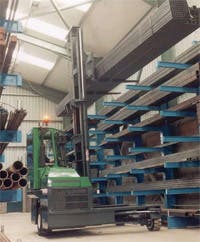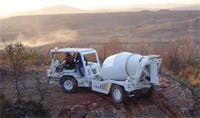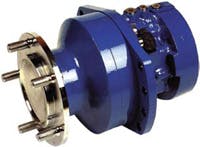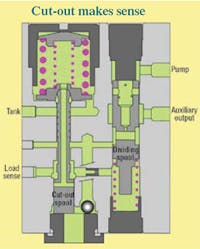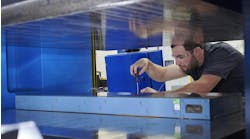Visit a construction site, mine, farm, or waste and recycling facility, and you’ll find a variety of heavy equipment run by hydraulics. Hydraulics is perhaps best known for the extreme force generated by hydraulic cylinders. However, the versatility and capabilities of hydrostatic drives are equally impressive in propelling and maneuvering heavy vehicles around work sites.
For decades, hydraulics has been used as the drive of choice for crawler-type (tracked) vehicles. Hydraulics not only steers vehicles by running each track at different speeds as needed for steering, but by driving one track forward, and the other in reverse, the vehicle can spin on its own axis. This capability has proven especially valuable at construction sites, where large vehicles often must operate in tight quarters.
Technology branches out
An offshoot of the crawler drive is the skid-steer drive. Like crawler drives, skid-steer drives can run wheels forward on one side of the vehicle, and in reverse on the other. But skid-steer vehicles can also allow wheels to pivot for steering. Power for steering is, of course, provided by hydraulics, and in many cases, front and rear wheels steer, which provides an extremely short turning radius while still providing the precise control necessary for high-speed travel.
So it should be no surprise why skid-steer equipment has become so commonplace; it combines the traction and maneuverability of a crawler drive with the greater control of conventional drives. Furthermore, hydraulics makes it easy to switch from one mode of operation to another. All an operator has to do is shift a hand-operated hydraulic valve or shift an electrical switch that shifts an electrohydraulic valve.
Another off-road vehicle closely identified with hydraulics is the forklift truck. From their inception, forklifts have zoomed up and down the aisles of warehouses and used their powerful hydraulic cylinders to effortlessly lift heavily loaded pallets of cargo in storage and retrieval operations. Although they operated offroad, their domain was the relatively smooth, flat surfaces of warehouse floors.
However, as warehousing began incorporating storage areas outside, a need arose for a forklift the could operate on irregular terrain. This gave rise to the all-terrain forklift. Arm them with a telescopic boom, and there’s almost nothing they can’t retrieve or put away.
A one-two combination
A different approach was taken by Combilift Ltd., Clontibret, Co. Monaghan, Ireland (available in the US from Combilift US, Greensboro, N.C.). Combilift builds machines that function as a conventional forklift and as a side-loading forklift. Side-loading forklifts are used for handling and transporting cargo consisting of long sections — pipe, tubing, lumber, etc.
For example, a conventional forklift could pick up and transport a 24-ft section of pipe, but it would not be able to move it through a 20-ft doorway or load it onto an 8-ft wide trailer. With a combilift, an operator would simply activate a switch that rotate’s the vehicle’s wheels 90°. This enables a combilift to move sideways.
The combilift is a 3-wheel machine, which makes it highly maneuverable and suitable for negotiating uneven terrain. Its 3-wheel hydrostatic drive provides high traction and multidirectional operation. It also features load-sensing hydraulic steering, and shifting wheels from forward-reverse driving to left-right is accomplished with the push of a button.
A concrete solution
But the advantages of hydraulics aren’t limited just to off-road equipment. Perhaps the most inconspicuous application where hydraulics has had a dramatic effect on advancing technology is seen in concrete mixer trucks. Prior to hydraulics, a variety of gear and chain drives were used to rotate the massive drum of concrete.
The main challenge had always been to rotate the drum at optimum speed, which was expensive and difficult to achieve with mechanical drives. This is because the engine runs within a wide range of speeds when the vehicle travels from the concrete plant to a job site. Consequently, the drum rotated faster and slower as the engine changed speeds or the driver shifted gears.
A hydraulic drive, on the other hand, turns the drum at a consistent speed, regardless of engine or ground speed. The hydraulic drive consists of a hydraulic power unit mounted within the framework of the truck, and a pair of hydraulic hoses route fluid to and from a low-speed, high-torque motor that drives the concrete drum.
Drum speed is regulated by hydraulic valves. The hydraulic system also powers auxiliary functions, such as concrete gate opening and closing and positioning of chutes.
Moving off road
The majority of concrete mixer trucks spend most of their time on roads and highways. However, when the construction site is a mine, tunnel, or other area with rough terrain, all-wheel drive and greater maneuverability is a must. That’s just what the Hurn 5, from Maquinaria Lorenzana, Madrid, Spain was designed for.
Maquinaria Lorenzana introduced the Hurn 5 concrete mixer truck earlier this year. Driven by a Deutz diesel engine that delivers 197 hp @ 2400 rpm, it uses hydraulics for virtually all functions — propulsion, steering, braking, and for driving the mixing drum, the engine’s cooling fan, water pump for mixing, and for actuating a pouring chute and related functions.
Hydraulics all around
The Hurn 5 relies on independent 4-wheel drive. Each wheel is driven by an MS18 hydraulic wheel motor, from Poclain Hydraulics, Verberie, France. The wheel motors are fed by a pair of variable-displacement, axial-piston pumps. The 4-wheel hydrostatic drive is lighter, smaller, and offers greater controllability than an equivalent mechanical drivetrain using shafts and gearing.
It also has an articulated center joint, which allows it to bend for tighter turning and for climbing over uneven terrain. It has a minimum inside turning radius of 5.7 m and can scale a 30% grade while carrying a full load (5 m3) of concrete.
The wheel motors provide 2-speed operation — accommodating speed ranges of 0 to 8 and 0 to 20 km/hr. Each MS18 motor is sized at 2100 cc/ rev and has an integral brake.t
The integral power brake system uses Poclain’s VB valves to control the service and parking brake. An integral anti-skid system, powered by a tandem-mounted variable-displacement hydraulic pump, gives the Hurn 5 excellent traction, which translates to high productivity and safety.
Multi-function modular valve
A key component of the Hurn 5 is a modular brake cut-out valve, also from Poclain Hydraulics. The cut-out valve ensures that the braking circuit and other hydraulic functions (steering, cylinders, etc.) are fed in sequence. It maintains a minimum pressure in brake accumulators, which are an essential part of the braking circuit by storing hydraulic pressure to provide power even if hydraulic power is lost.
To charge the accumulators with pressurized fluid, a flow divider directs a constant flow of fluid from the pump to the accumulators. When maximum pressure of the brake circuit is reached (cut-out pressure), the valve shifts to stop charging the accumulators and direct pump flow to the auxiliary circuit. When the brake is actuated, pressure in the accumulators drops. When it drops to its lowest limit (cut-in pressure), the valve shifts to redirect fluid to charge the accumulators.
The modular valve also accommodates load sensing, which conserves energy when hydraulic power is not required. This is accomplished by a proportional load-sense signal that modulates the pump’s displacement when required. The load-sense signal is triggered by the pressure at the load-sensing port of the cut-out valve.
When the accumulators operate between the cut-in and cut-out pressures, the load sensing port sends no pressure signal to the pump. As a result, pump displacement is restricted to the volume required to feed auxiliary functions. When pressure drops to the cut-in value, the load sense port sends a signal to the pump. Pump displacement automatically increases and the accumulators are rapidly charged to reach the cut-out pressure level.
The combination of features conserves power. Also, braking is available even if the engine stalls or hydraulic power is lost through some other cause. The cut-out valve guarantees that the pressure in the accumulators is sufficient to brake efficiently at any time. Furthermore, the cut-out valve ensures that auxiliary functions, such as steering, are constantly supplied with oil.
In North America, contact Poclain Hydraulics Inc., Sturtevant, Wis., at (262) 321-0679, or visit www.poclainhydraulics.com.

